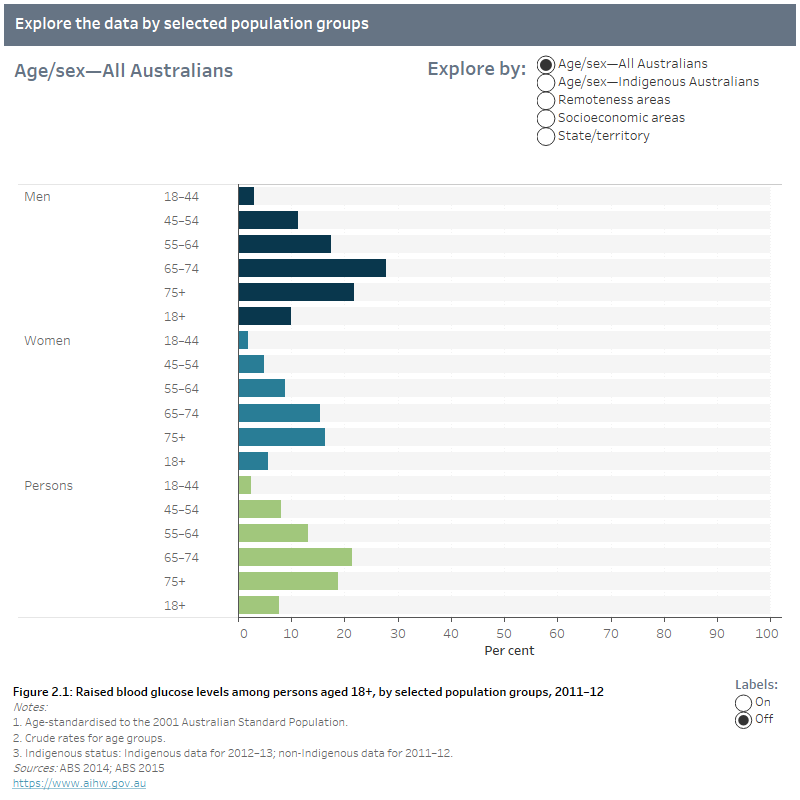Indicator 2.1 Raised blood glucose levels (including diabetes)
Considerations
- Data for this indicator are not available for update—baseline results reported.
- Additional baseline results for the proportion of Australian adults with diabetes or impaired fasting plasma glucose have been provided.
Overview
Based on measured data from the 2011–12 ABS Australian Health Survey, it was estimated that around 1.1 million (8.2%) of Australians aged 18 and over had raised blood glucose levels (fasting plasma glucose ≥ 6.1mmol/L comprised of 5.1% of those who had diabetes and 3.1% who had impaired fasting plasma glucose).
Age and sex
The age-standardised proportion of men with raised blood glucose levels was higher than the proportion of women in each age group, and the prevalence increased with age between 18 and 74 years for both men and women. An estimated one in five adults aged 65 to 74 had raised blood glucose levels (including diabetes) (Figure 2.1).
Population groups
Adults living in the lowest socioeconomic areas had a higher prevalence of raised blood glucose levels than those living in the highest socioeconomic areas (12% and 5%, respectively). After adjusting for age, there were no significant differences by remoteness area (Figure 2.1).
State and territory
After adjusting for age, there were no significant differences in the prevalence of raised blood glucose levels by state and territory (Figure 2.1).
Aboriginal and Torres Strait Islander people
In 2012–13, 16% of Indigenous adults had raised blood glucose levels, based on data from the Aboriginal and Torres Strait Islander Health Survey. There was no difference between the age-standardised proportion of Indigenous men and women with raised blood glucose levels.
Explore the data
2.1 Raised blood glucose levels among persons aged 18+, by selected population groups, 2011–12
The figure shows the proportion of adults with raised blood glucose levels, by selected population groups in 2011–12. Overall, 7.7% of adults had raised blood glucose levels in 2011–12. Among All Australians, the proportion with raised blood glucose levels peaked in the 65–74 age group for males and 75+ age group for females. Among Indigenous adults, there was no variation among males and females (15.8%). Proportions were similar by remoteness area and increased slightly with the level of socioeconomic disadvantage (from 5% in the highest to 12% in the lowest socioeconomic areas). Among the states and territories, the age-standardised proportion of adults with raised blood glucose levels ranged from 7.3% in Victoria to 11.1% in the Northern Territory.

|
|
Definition |
Data source |
|---|---|---|
|
Numerator |
Estimated number of adults (18+) with raised blood glucose or diabetes (fasting plasma glucose ≥ 6.1mmol/L). |
ABS 2015; ABS 2014
|
|
Denominator |
Estimated Australian population (18+years). |
ABS 2015; ABS 2014
|
References
Australian Bureau of Statistics (ABS) 2014. Microdata: Australian Health Survey, Core Content - Risk Factors and Selected Health Conditions, 2011–12. ABS cat. no. 4324.0.55.003. Findings based on Detailed Microdata analysis. Canberra: ABS.
ABS 2015. Microdata: Australian Aboriginal and Torres Strait Islander Health Survey, Core Content - Risk Factors and Selected Health Conditions, 2012–13. ABS cat. no. 4715.0.30.003. Findings based on Detailed Microdata analysis. Canberra: ABS.


